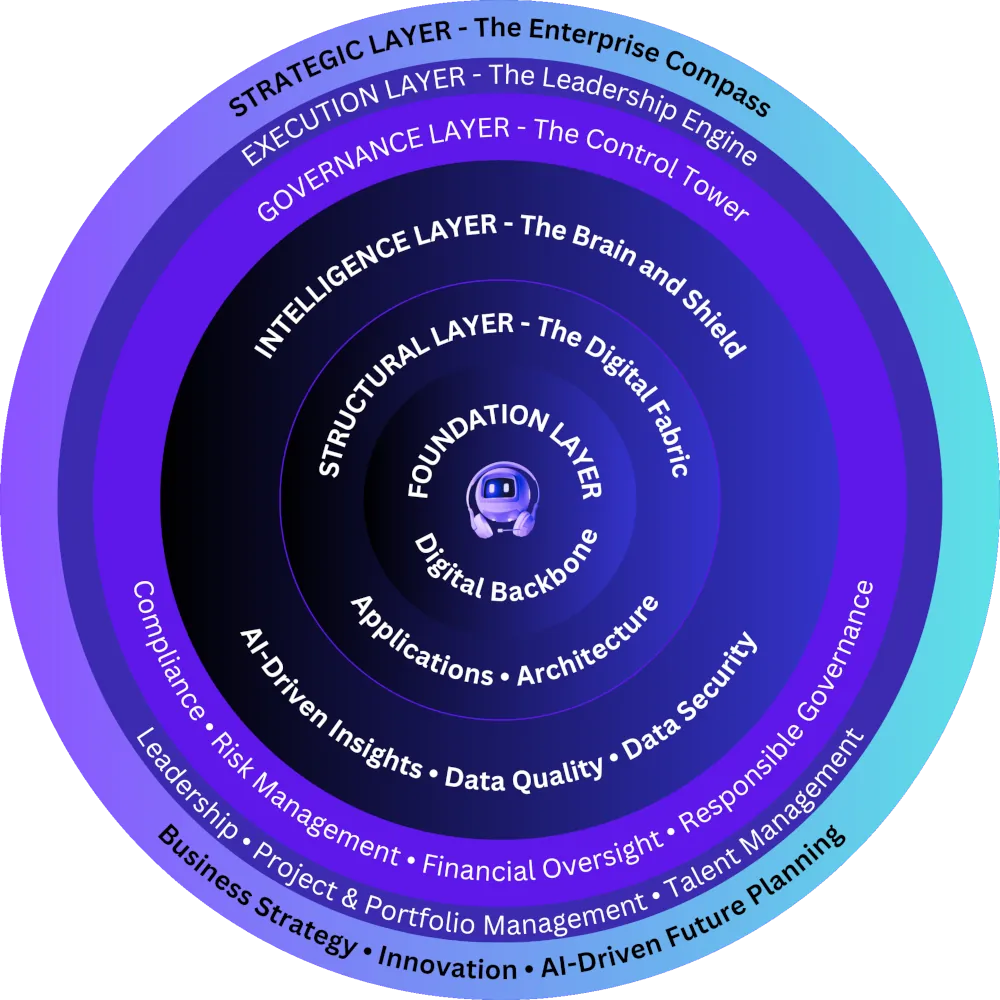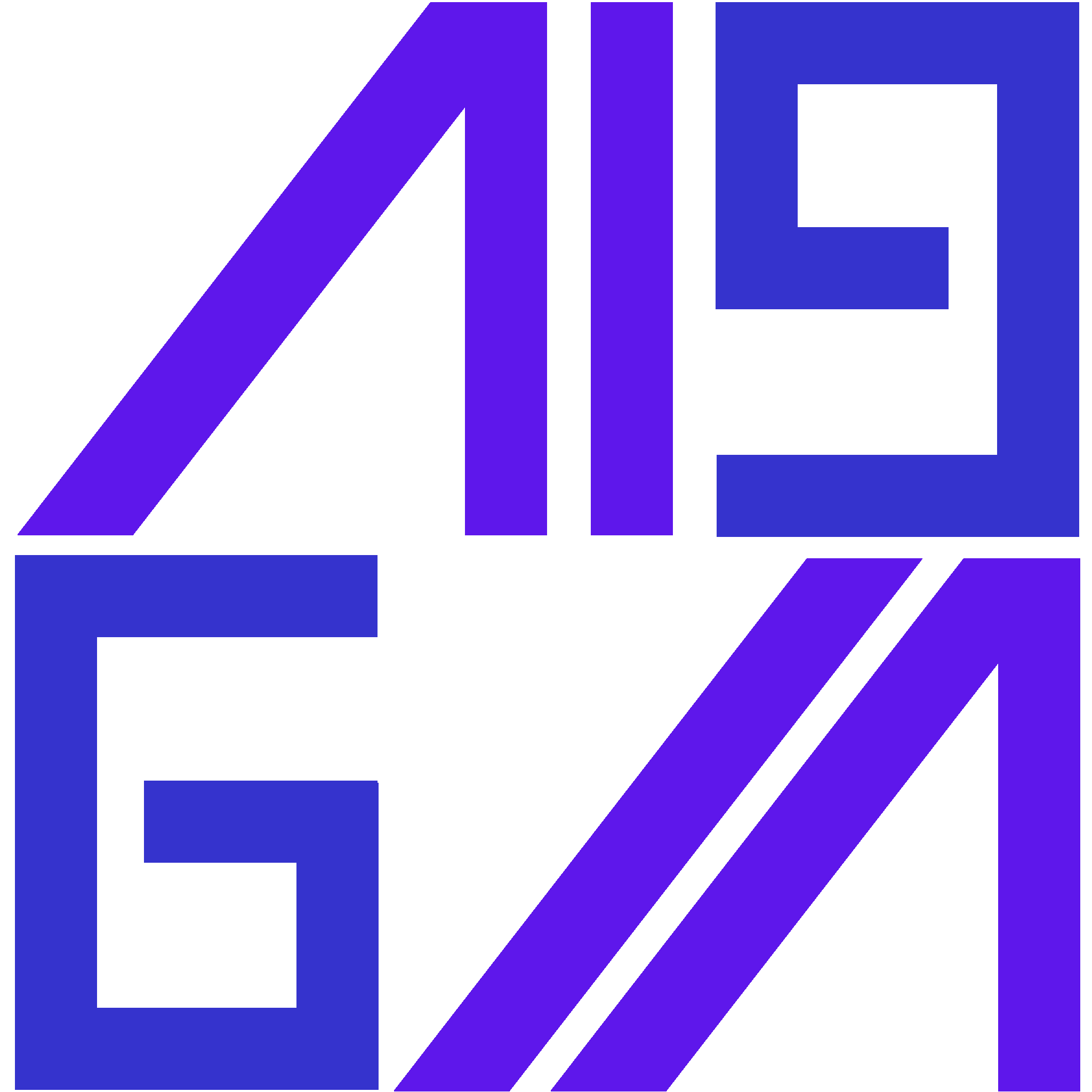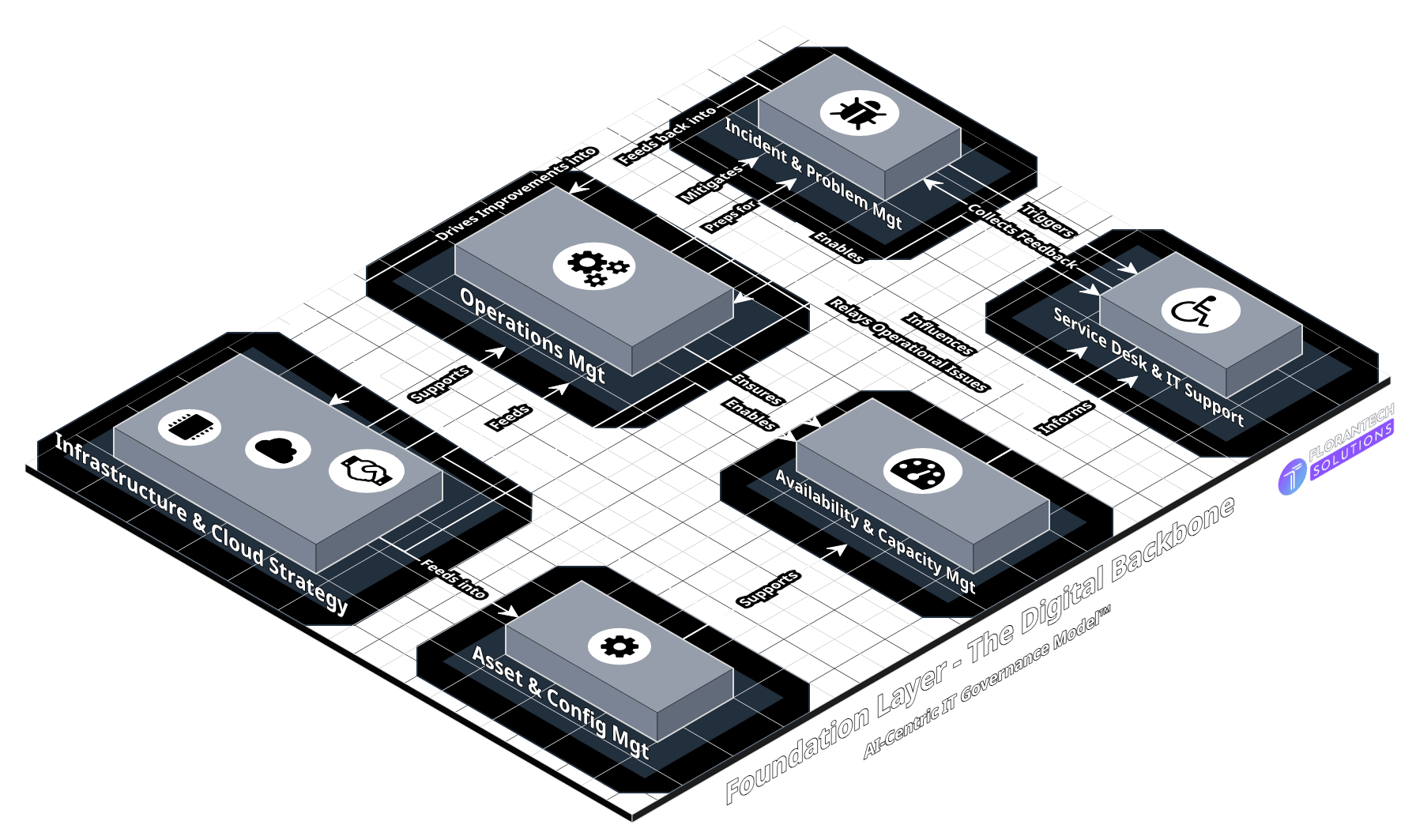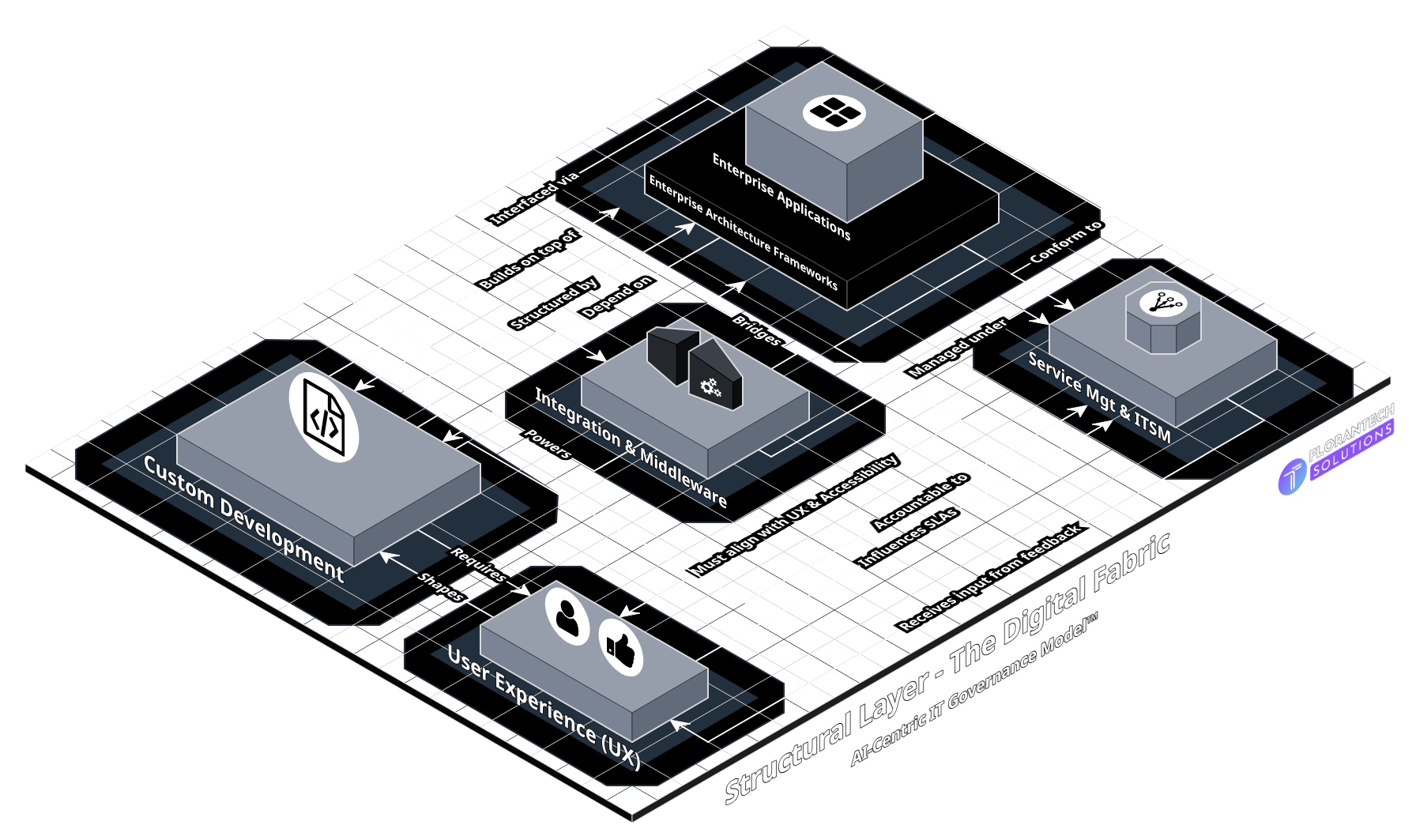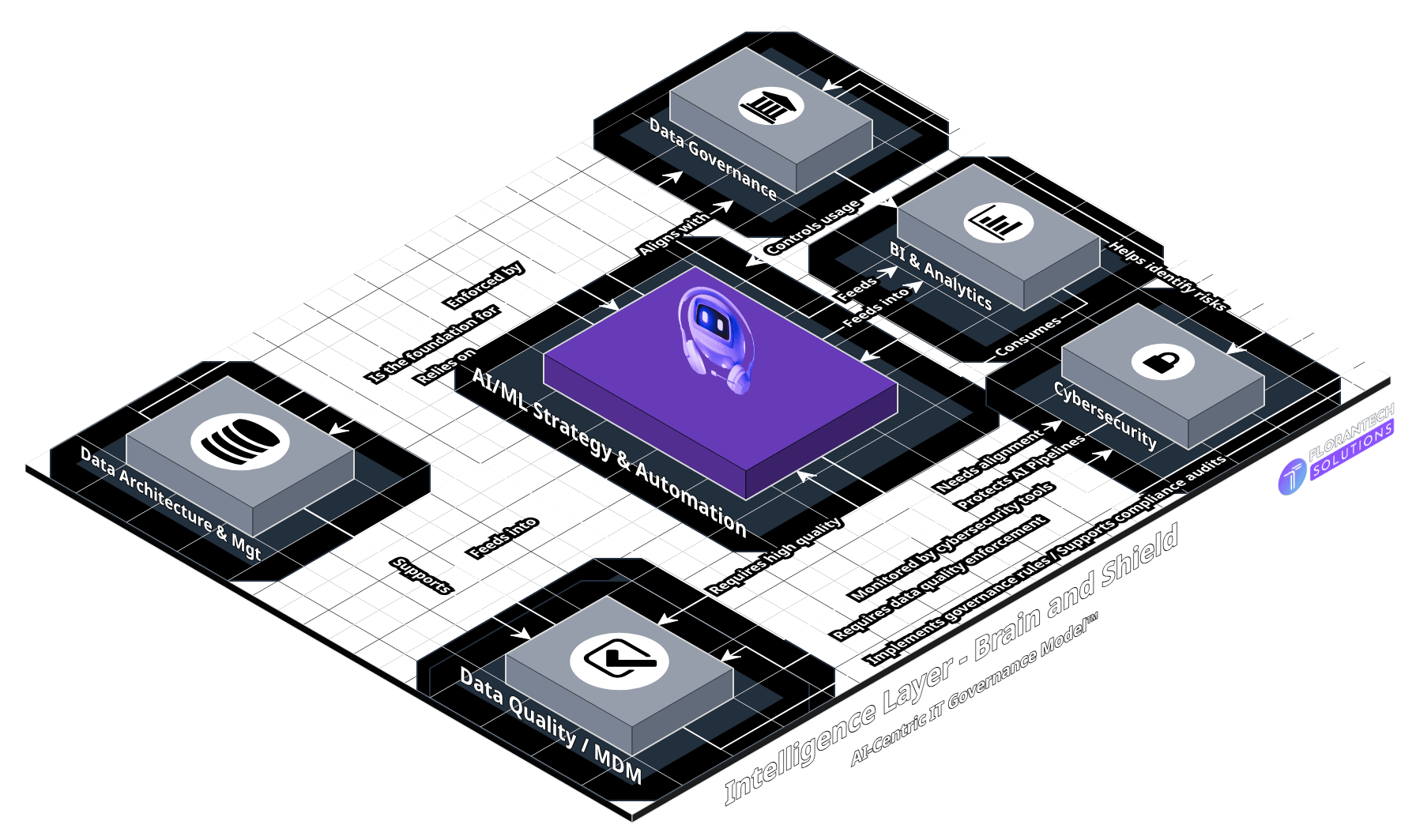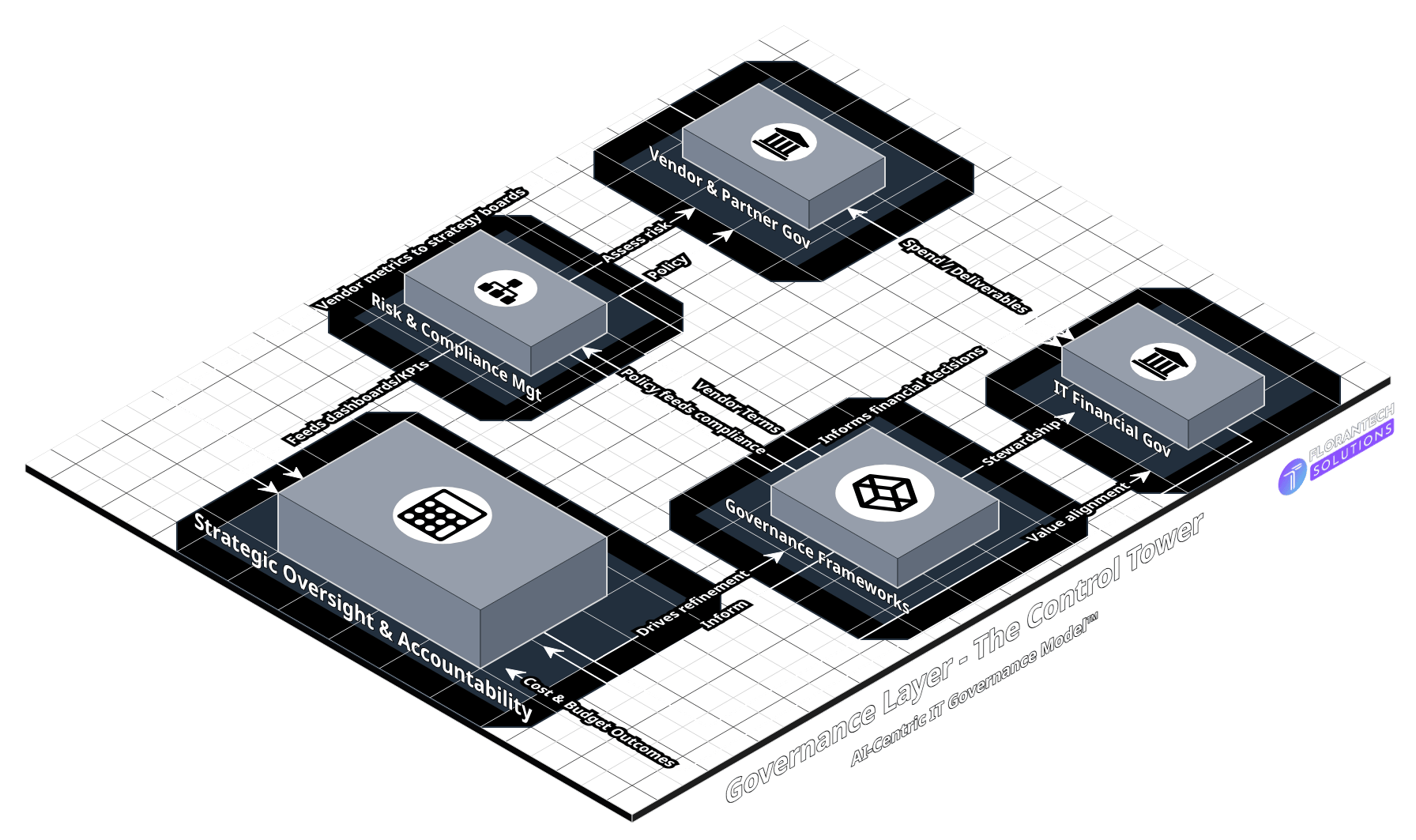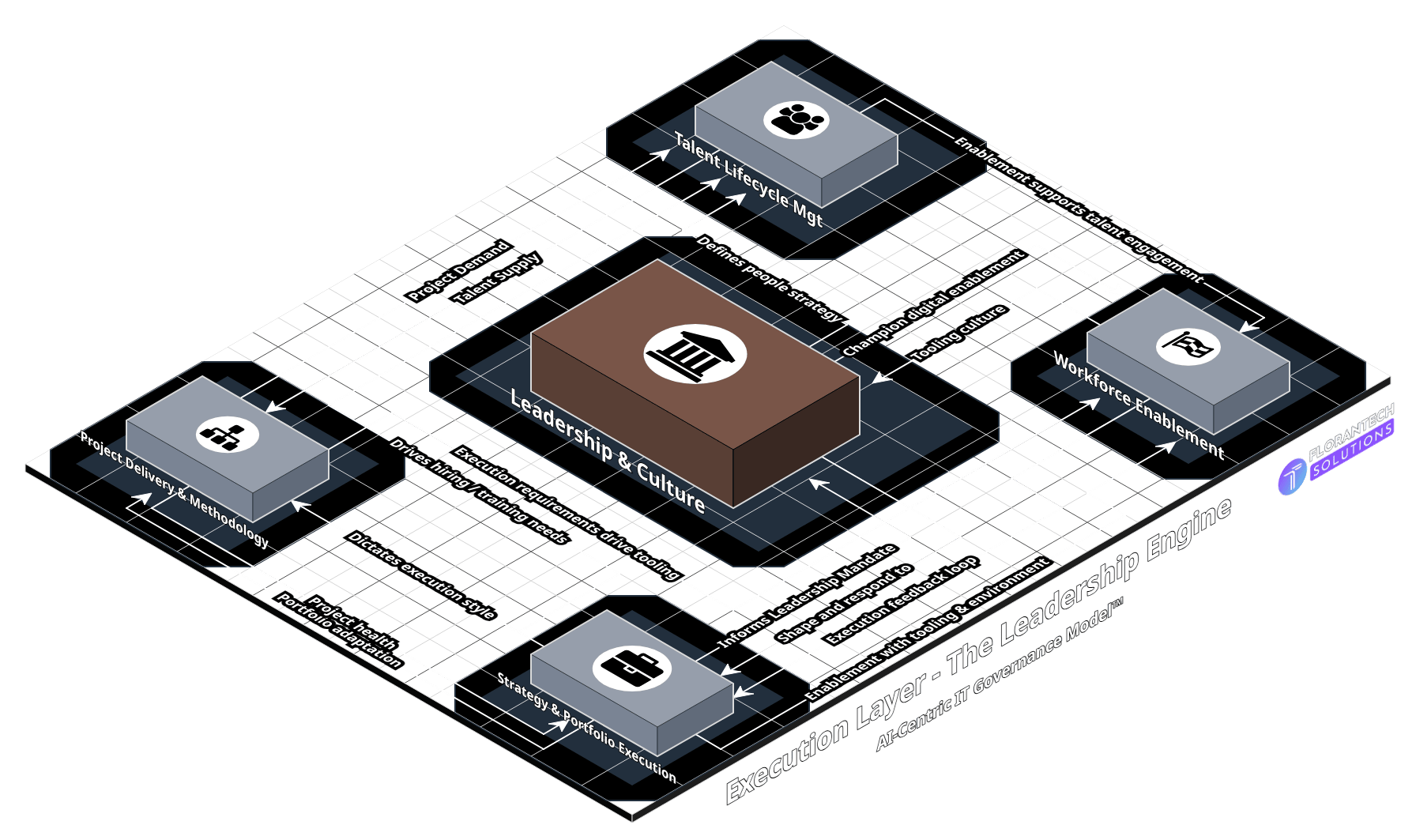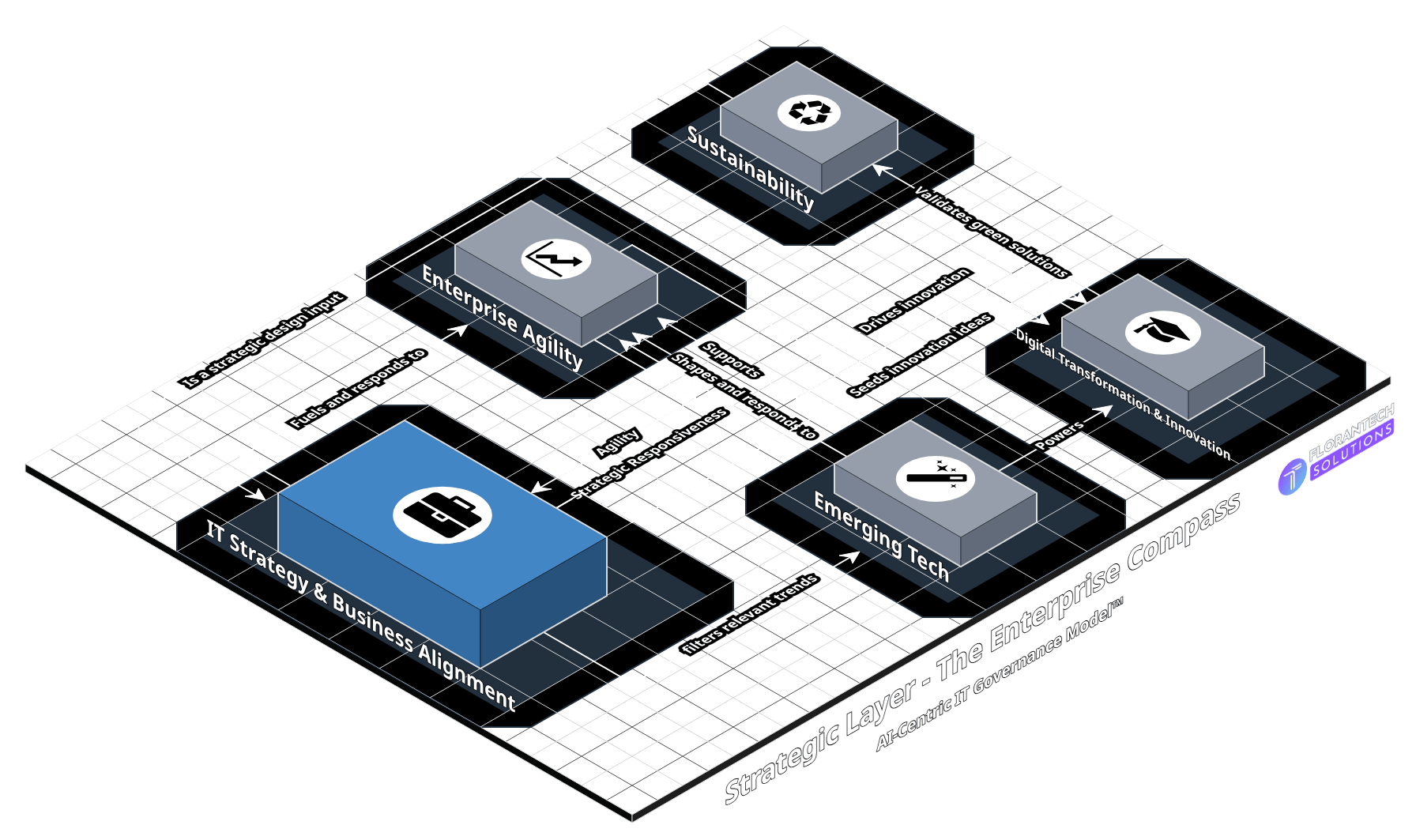AI9GM
FOREWORD
A Note on Scale
If you're a startup or small to medium-sized business (SME):
Think of this framework as a north star, not a checklist. You won’t need every component today — and that’s okay. Focus on what accelerates growth, reduces risk and avoids costly rework. This model helps you scale wisely when the time comes.
If you're a growing or established enterprise:
This framework offers a holistic view of AI-Centric IT Governance. It bridges infrastructure, intelligence, execution and strategy — empowering you to modernize, align with business goals and lead with resilience.
Analogy: Think of this model like a city master plan.
A startup is a food truck — it doesn’t need zoning bylaws or a transit authority.
But once it becomes a food court, then a restaurant chain, then a downtown block, you wish you'd planned (among other things) the plumbing, security and staffing early.
Yet Another Framework?
Perhaps. But think of this as a meta-framework — one that sits on top of established standards. It doesn’t aim to replace them. Instead, it draws from decades of lessons — from the simplicity of CP/M and MS-DOS days to the cloud-native, AI-driven world we live in today.
We’ve built this because we believe AI modernization isn’t just a technical journey — it’s a systemic one.
AI strategies often fail not due to lack of ambition, but because of weak data governance, security blind spots or misaligned IT infrastructure. By visualizing your entire technology landscape through our framework's lens, you gain the clarity to prioritize, coordinate and scale AI efforts responsibly.
It’s not about checking every box — it’s about seeing the full picture before you even move the pieces.
The AI-Centric IT Governance Model™ (AI9GM) consists of six abstraction layers.
- Foundation Layer - The Digital Backbone
- Represents the fundamental infrastructure and operational stability of IT
- Structural Layer - The Digital Fabric
- Represents applications and architecture that form the structure supporting business functions
- Intelligence Layer - The Brain & Shield
- Represents AI Strategy, AI-driven Insights, data quality and security mechanisms
- Governance Layer - The Control Tower
- Ensures compliance, risk management and financial governance
- Execution Layer - The Leadership Engine
- Focuses on managing projects, portfolios and talent
- Strategic Layer - The Enterprise Compass
- Represents business strategy, innovation and AI-driven future planning
Understanding The Layers
The following sections may contain technical terms and industry jargon in key areas. However, each layer begins with a ‘Big Picture Insight’ that simplifies the key area points in plain language.
The Digital Backbone
1️⃣ CORE – Foundation Layer
Represents the fundamental infrastructure and operational stability of IT
Infrastructure is the backbone (Core). Everything depends on it.
💡 Big Picture Insight
Think of this as the foundation of a building — without it, nothing else stands. This layer enables your company’s technology to run smoothly, stay online and scale as needed. It covers everything from cloud strategy to IT support, keeping systems reliable, secure and always available.
Why It Matters for AI Modernization
AI relies on a strong digital backbone. Without stable infrastructure, even the most advanced AI solutions will struggle with performance, downtime and data bottlenecks. A well-architected IT foundation is key for AI systems to have the computing power, storage and reliability needed to operate at scale and deliver real business impact.
🚀 Why Work With Us?
We are knowledgeable and functional in this domain. We don’t just deploy AI on top of existing infrastructure — we architect and optimize the digital backbone itself. Unlike others who rely heavily on third-party providers, we minimize the risk of your data being compromised with a scalable foundation that gives you full control, security and efficiency.
Figure 1: AI9GM™ Layer 1 (Foundation Layer - The Digital Backbone)
📈 IT Dollars and Sense
- Infrastructure is the "platform everything else rides on" — heaviest cost driver.
- Operations is second because keeping systems alive and updated is a continuous, expensive task.
- Availability/Capacity is very costly when you have serious uptime/disaster recovery needs (e.g., 99.999% SLA targets).
- Asset and Config Management is a middleweight — needs attention but scales relatively linearly.
- Service Desk and Incident Management — small from a dollar cost, but critical for perception of IT value.
⚙️ Key Areas
Each component is like a crucial element in building a strong, reliable and scalable structure.
- Infrastructure and Cloud Strategy – On-premise vs. cloud, hybrid strategies, scalability.
- Asset and Configuration Management – IT asset tracking, CMDB, lifecycle management.
- Operations Management – Monitoring, maintenance, automation, DevOps and SRE practices.
- Availability and Capacity Management – Ensuring uptime, performance monitoring, disaster recovery.
- Incident and Problem Management – ITSM processes for resolving incidents and addressing root causes.
- Service Desk & IT Support – User support, ticketing systems, SLAs, IT self-service portals.
The Digital Fabric
2️⃣ Layer 2 – Structural Layer
Represents applications and architecture that form the structure supporting business functions
Applications and architecture define how business runs on the (Foundation Layer) infrastructure.
💡 Big Picture Insight
If infrastructure is the foundation, this layer is the framework of the building — how everything is structured and connected. It facilitates business applications, integrations and IT systems to work together, supporting day-to-day operations and long-term growth.
Why It Matters for AI Modernization
AI isn’t just an add-on. It must integrate with existing business systems to deliver real value. A well-structured application and architecture layer guarantees that AI can access the right data, interact with enterprise systems and enhance user experiences without creating silos or inefficiencies.
🚀 Why Work With Us?
This is another one of our domain skills. With decades of software development experience, we understand the nuances of building and optimizing the entire application ecosystem. Success isn’t just about knowing how to build AI — it’s about knowing how NOT to build it. We avoid common pitfalls by making sure that AI integration works well with your technology assets.
Figure 2: AI9GM™ Layer 2 (Structural Layer - The Digital Fabric)
💡Digital Fabric: Think of it as "Tapestry"
- Architecture is the loom.
- Enterprise Apps are the threads.
- Middleware is the weave.
- Custom Development is the needlework.
- UX is the pattern.
- ITSM is the rules how the tapestry is built, maintained and repaired.
⚙️ Key Areas
Applications & Integration
- Enterprise Applications – ERP, CRM, SCM, HRMS, business-critical systems.
- Custom Software Development – Internal and external software engineering efforts.
- Application Lifecycle Management (ALM) – Development, testing, deployment, maintenance.
- Integration & Middleware – API management, service orchestration, microservices.
- User Experience (UX) & Accessibility – Designing applications that are intuitive and accessible.
Architecture & Standards
- Enterprise Architecture Frameworks – TOGAF, Zachman Framework.
- Service Management & ITSM – ITIL, COBIT frameworks, ensuring service alignment with business.
- IT Product Management – Overseeing IT systems as products, prioritizing features, roadmaps.
- Standards & Best Practices – Ensuring adherence to security, compliance and interoperability.
- Technology Roadmaps & Rationalization – Avoiding redundant technologies, ensuring alignment.
The Brain and Shield
3️⃣ Layer 3 – Intelligence Layer
Represents AI Strategy, AI-driven Insights, data quality and security mechanisms
Intelligent data and security govern information flow and risk management.
💡 Big Picture Insight
This layer is both the brain and the shield of your digital ecosystem. Data fuels intelligent decision-making while security ensures that information remains protected. Collectively, they enable businesses to harness AI, extract meaningful insights and mitigate risks in an increasingly data-driven world.
Why It Matters for AI Modernization
AI is only as good as the data it learns from. Security is non-negotiable. A strong data strategy enables AI to operate on high-quality, well-governed information. Robust cybersecurity safeguards sensitive data from threats. Without this layer, AI efforts risk being inaccurate, non-compliant or vulnerable to attacks.
🚀 Why Work With Us?
This layer is where we really shine. AI isn’t just about models — it’s about data, security and intelligent insights. With a strong focus into AI, data architecture, data governance and cybersecurity, we design AI built on a foundation of trust, accuracy and compliance. While others treat AI as a black box, we engineer transparent, secure and high-performing AI solutions that drive real business value.
Figure 3: AI9GM™ Layer 3 (Intelligence Layer - The Brain and Shield)
💡 Useful Analogy
AI/ML Strategy & Automation = The Neocortex (thinking, decision-making)
BI & Analytics = The Eyes (perception, vision)
Data Architecture + Data Quality = Nervous System (signals, structure, quality)
Governance = Conscience (ethical filter)
Cybersecurity = Immune System (threat detection and response)
Privacy & Compliance = Legal and Moral Boundaries (what is permitted)
⚙️ Key Areas
AI + Data
- AI/ML Strategy & Automation – AI adoption, model development, data-driven decision-making.
- Data Architecture & Management – Data lakes, warehouses, structured/unstructured data strategies.
- Data Quality & Master Data Management – Ensuring accurate, consistent and reliable data.
- Data Governance & Compliance – Policies, data privacy laws (GDPR, CCPA), ethical AI usage.
- Business Intelligence & Analytics – Dashboards, reporting, predictive analytics, insights.
Data Security
- Cybersecurity Strategy & Threat Management – Cyber defense, threat intelligence, SOC operations.
- Privacy & Compliance – Regulations (ISO 27001, NIST, GDPR, HIPAA, PCI-DSS).
- Identity & Access Management (IAM) – SSO, MFA, role-based access control (RBAC).
- Security Operations & Incident Response – SIEM, forensic analysis, response plans.
- Risk & Vulnerability Management – Continuous assessments, penetration testing, audits.
The Control Tower
4️⃣ Layer 4 – Governance Layer
Enforces compliance, risk management, and financial governance
Governance and financial controls ensure IT is compliant and cost-effective.
🛠️ Big Picture Insight
This layer acts as the control tower which enforces IT to stay compliant, cost-effective and aligned with business objectives. It sets the rules, manages risks and optimizes spending so that technology investments deliver maximum value while avoiding regulatory pitfalls.
Why It Matters for AI Modernization
AI initiatives can quickly become costly and risky without proper governance. Strong financial oversight makes sure AI investments generate ROI. Compliance frameworks prevent legal and ethical missteps. Without this layer, AI adoption could lead to uncontrolled costs, security risks or regulatory violations.
🚀 Why Partner With Us?
Strong AI governance helps maintain compliance, security and financial sustainability. While we focus on the Intelligence Layer aspects, we recognize that governance frameworks are essential for long-term success. If you need specialists in risk, compliance or IT finance, we can point you in the right direction.
Figure 4: AI9GM™ Layer 4 (Governance Layer - The Control Tower)
⚙️ Key Areas
Governance Frameworks and Policy Management
- IT Governance Frameworks – COBIT, ITIL, ISO 38500, reinforcing alignment with business goals.
- Policy Development & Enforcement – Standard operating procedures, IT policies.
- Auditing & Reporting – Internal/external audits, compliance tracking, IT ethics.
Risk & Compliance Management
- Risk Management – Enterprise risk assessments, mitigation plans, reporting.
- Compliance Management – Regulatory adherence (SOX, GDPR, HIPAA, etc.).
IT Financial Governance
- IT Budgeting & Cost Optimization – CapEx vs. OpEx, chargeback/showback models.
- Cloud & SaaS Cost Management – Usage optimization, cloud cost governance.
- Technology Investment Planning – ROI analysis, evaluating emerging tech investments.
Vendor Partner Governance
- Procurement & Contract Management – Vendor negotiations, SLAs, licensing agreements.
- Vendor Risk Management – Assessing vendor security, compliance, performance.
Strategic Oversight & Accountability
- Ties it all to business goals via metrics, ethics and performance
The Leadership Engine
5️⃣ Layer 5 – Execution Layer
Focuses on managing projects, portfolios and talent
Project management and leadership execute IT strategies.
🚀 Big Picture Insight
This layer is where strategy turns into action. Strong leadership, structured project management and skilled talent facilitate IT and AI initiatives to be executed effectively. This keeps teams aligned, projects on track and innovation moving forward.
Why It Matters for AI Modernization
AI transformation isn’t just about technology — it’s about people and execution. Without strong leadership, project governance and talent development, even the best AI strategies can fail. This layer helps keep AI initiatives well-managed and adopted effectively.
🚀 Why Partner With Us?
AI is only as effective as the teams that implement and manage it. Project execution, leadership and talent strategy are key to realizing AI’s potential. While we focus on the technology layers, we value strong partnerships with experts who drive organizational change.
Figure 5: AI9GM™ Layer 5 (Execution Layer - The Leadership Engine)
⚙️ Key Areas
Strategy and Portfolio Execution
- IT Portfolio Management – Aligning IT projects with business goals, prioritization.
- PMO & Governance – Establishing policies for project execution, risk mitigation.
- Change Management & Digital Adoption – Ensuring smooth transitions for new IT initiatives.
Project Delivery and Methodologies
- Agile & Waterfall Methodologies – Managing IT projects efficiently with the right frameworks.
- Resource & Capacity Planning – Ensuring adequate staffing, skills allocation.
- KPIs & Performance Metrics – Tracking success with OKRs, CSFs and key performance indicators.
Leadership and Culture
- IT Leadership & Culture – CIO, CTO, CAIO, CISO leadership strategies, fostering innovation.
- Focus on vision, innovation, executive alignment and leadership tone.
Talent Lifecycle Management
- Talent Acquisition & Development – Hiring, training, succession planning.
- Focus on People strategy – skills, hiring, development, retention
Workforce Enablement & Productivity
- Workforce Collaboration & Productivity – Tools, remote work enablement, hybrid workforce strategy.
- Focus on collaboration tools, hybrid work support and performance efficiency
The Enterprise Compass
6️⃣Layer 6 – Strategic Layer
Represents business strategy, innovation and AI-driven future planning
Strategy and innovation sit at the outermost layer. They drive future IT and AI directions but depend on all inner layers for execution.
🧭 Big Picture Insight
This layer is the enterprise’s compass, setting the direction for innovation and long-term success. It focuses on technology investments to align with business goals, keeping the organization competitive, agile and future-ready.
Why It Matters for AI Modernization
AI isn’t just a tool — it’s a strategic enabler. Without a clear vision and alignment with business objectives, AI initiatives can become scattered experiments rather than game-changing innovations. This layer enables AI to be leveraged thoughtfully, driving transformation while maintaining agility and sustainability.
🚀 AI Execution and Beyond
AI should align with your business vision, not just your tech stack. We work with forward-thinking leaders to integrate AI into strategic roadmaps. Need insights on digital transformation or enterprise agility? We can connect you with trusted advisors in our network.
Figure 6: AI9GM™ Layer 6 (Strategic Layer - The Enterprise Compass)
⚙️ Key Areas
- IT Strategy & Business Alignment – Bridging business needs with IT capabilities.
- Emerging Technologies & Trends – Exploring AI, quantum computing, blockchain, edge computing.
- Digital Transformation & Innovation Labs – Rapid prototyping, R&D, testing new business models.
- Enterprise Agility & Competitive Advantage – Ensuring IT is a driver of business agility.
- Sustainability & Green IT – Eco-friendly IT initiatives, carbon footprint reduction.
🎯 Final Takeaway
This framework offers a strategic view of the digital foundation required to support meaningful AI adoption. True AI modernization isn’t just about deploying models — it’s about aligning infrastructure, data, leadership and strategy to enable responsible, scalable and high-impact AI.
But modernization doesn’t mean starting from scratch — or implementing everything at once.
If you're a startup or a growing business, use this framework as a guiding reference, not a prescriptive roadmap. A strategic compass, not a checklist. Adopt what helps you move faster, smarter, and safer — and revisit the rest as your scale and complexity grow.
Ultimately, the goal is not governance for its own sake — but governance that enables progress.
© 2025 • Florante Pascual • All Rights Reserved


